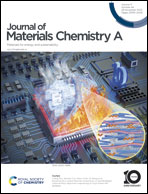Sulfonate compounds embraced from acid copper electroplating baths as innovative additives for alkaline Zn batteries†
Abstract
Nickel–zinc (Ni–Zn) batteries are rechargeable (secondary) aqueous batteries with high theoretical power density and a considerably low cost in addition to being safe and rather sustainable. Currently, the cycle life of these batteries is still insufficient to keep up with other common industrially available battery chemistries. This insufficiency is a result of dendrite formation, parasitic hydrogen evolution, corrosion, passivation, and dynamic character of morphology evolution. The application of electrolyte additives is a simple and cost-effective method to address these challenges and promote alternative beneficial layer-like morphologies. This work reports on the positive effects of additive combination, inspired by embracing and optimizing additives, originating from copper (Cu) electroplating in the very large system integrated (VLSI) microelectronic field. Here, we report on the vast impact of bis(sodium-sulfo-propyl) disulfide (SPS) and other sulfur-based derivatives, such as sodium 3-(dimethylcarbamothioylsulfanyl) propane-1-sulfonate (DPS) and 3-S-isothiuronium propyl sulfonate (UPS) on Zn deposition and growth morphology and hydrogen evolution and corrosion processes. Integrating the optimized additive-modified electrolyte into a full-cell assembly reveals that the unique combination of additives can reduce protrusion growth with a minimal polarization loss, resulting in an extended cycle life of the advanced Ni–Zn battery of up to 2000 cycles in a deep discharge regime.



 Please wait while we load your content...
Please wait while we load your content...